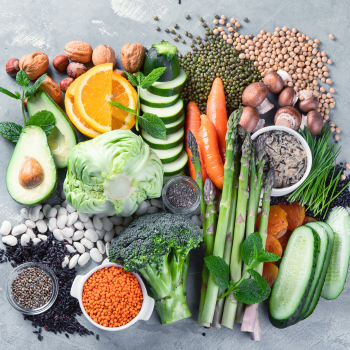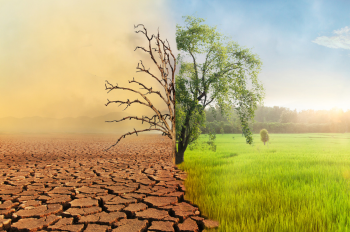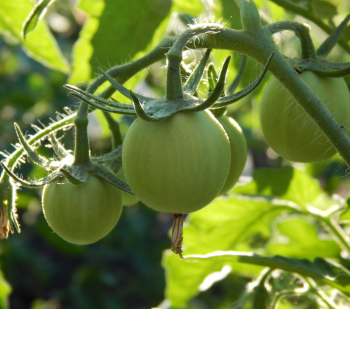by Cristin Middlebrooks, AWC Antwerp
As I am writing this article, Los Angeles is on fire. More than 35,000 acres have burned, leaving thousands of people homeless. Dangerous conditions, brought on by climate change, came together to make these some of the worst fires on record. In an interview on PBS, Gavin Schmidt, the director of the NASA Goddard Institute for Space Studies, pointed to the “whiplash between extreme wet events and extreme dry events, leading to a spurt of growth when there was water and now all of that growth has dried out, providing a perfect storm for fires this season.” Combine that scenario with the strong Santa Ana winds and you have a recipe for disaster.
 The planet is getting warmer. Each year we break last year’s record for the warmest year ever. Ice caps are melting and sea levels are rising, threatening coastlines and causing irreparable damage to coral reefs. The list of tragedies linked to climate changes goes on and on. The worst part of it all is that unlike other mass extinctions in the planet’s history, we are solely responsible for this one.
The planet is getting warmer. Each year we break last year’s record for the warmest year ever. Ice caps are melting and sea levels are rising, threatening coastlines and causing irreparable damage to coral reefs. The list of tragedies linked to climate changes goes on and on. The worst part of it all is that unlike other mass extinctions in the planet’s history, we are solely responsible for this one.
Okay. We know things are bad and most of us know that something has to change, but how? The biggest issue when it comes to solving climate change is the sheer size of the problem. It’s overwhelming and difficult to see how one person can make an impact. We recycle. We drive fuel-efficient cars or take public transportation. We limit the time we spend in airplanes. Those are helpful, but there’s one sacrifice that is rarely talked about. The biggest impact we as individuals can have on the planet is to stop, or severely cut back, eating products made from animals.
“Animal agriculture produces 65% of the world’s nitrous oxide emissions, which has a global warming impact 296 times greater than carbon dioxide,” according to a 2022 study out of the University of Colorado Boulder. Due to high demand for inexpensive beef, poultry and pork products, most animals are raised in warehouse-like conditions, packed to the brim in cages, crates, pens and stalls. Since it’s not practical or cost-efficient to feed these animals their natural diet, they must be fed a grain and high-protein diet designed to speed growth. These diets, and the horrifying living conditions they are subjected to, make the animals sick, so they must also be given hefty doses of antibiotics. The residue of these drugs and the massive amount of manure these animals create cannot be used as fertilizer so it is sent back out to the environment, polluting nearby bodies of water, killing fish and destroying surrounding natural habitats.
The pollution created by these poor animals isn’t factory farming’s only threat to the environment. In the 1980s, farming saw a monumental shift, moving from small farms maintained by people in touch with the land to big corporations devoted to making as much money as possible from each acre – and what’s worse, our taxes are helping to fund them. “Today, public dollars are concentrated on the large operator growing what we need less of – corn and soy for feed and ultra-processed foods,” according to Frances Moore Lappé in her groundbreaking book Diet for a Small Planet, originally published in 1971 and revised in 2021. “As monoculture spreads and crop rotation declines,” she continues, “topsoil across our earth is washing or blowing away at a rate 10 to 40 percent faster than nature can build it.” The tremendous waste of water is another effect of overproduction. It takes 1,800 gallons of water to produce one pound of beef, 50 times more than for a pound of any vegetable.
To sum up the effects of factory farms on climate change, I want to include a few distressing facts I found in Jonathan Safran Foer’s book, We are the Weather: Saving the Planet Begins at Breakfast: 
- Since the advent of agriculture approximately 12,000 years ago, humans have destroyed 83% of all wild animals and half of all plants.
- Globally, humans use 59% of all the land capable of growing crops to grow food for livestock.
- 70% of the antibiotics produced globally are used for livestock, weakening the effectiveness of antibiotics to treat human diseases.
- Between 1950 and 1970, the number of American farms declined by half, the number of people employed in farming declined in half, and the size of the average farm doubled. During that time, the size of the average chicken also doubled.
- People who eat diets high in animal protein are four times as likely to die of cancer as those who eat diets low in animal protein.
- About 80% of deforestation occurs to clear land for crops for livestock and grazing.
- Animal agriculture is responsible for 91% of Amazonian deforestation.
Going completely plant-based may be difficult for some. However, what if we began with one meal a day? What if we spent more on quality meat and ate it less frequently? Eating meat at every meal is a relatively recent phenomenon. Do we really need to eat bacon for breakfast, turkey slices for lunch and steak for dinner? With this rise also comes the rise in diseases such as diabetes, heart disease and certain cancers. Whole grains and vegetables have comprised the majority of our meals throughout most of history. Maybe it’s time to let history repeat itself. Unlike fossil fuels or governments pulling out of climate accords, our diets are something we have absolute power over. Switching to a diet composed mainly of plants is not only better for your health, it’s much better for the environment.
In his introduction, Safran Foer reminds the reader how everyday Americans contributed to the effort to win World War II on the homefront. Even though their lives weren’t at risk and the biggest dangers were happening somewhere else, they knew the threat was real and were determined to play their part. They participated in blackouts. Meat was rationed, backyard vegetable gardens became the norm, and tightening belts became a source of patriotism. That collective action is what it will take to save the planet. We will all have to make sacrifices if we want this planet to survive, and the easiest action to take is to stop eating animal products, especially meat that comes from factory farms and is raised on grain produced by big agriculture.
I’m well aware that telling people to change their diet is not popular. I became a vegetarian back in 1992, but it is not always easy. I have a husband and two teenage boys who look forward to their summer visits to the United States where they can eat chicken fried steak in Texas and Grandpa’s barbecued ribs in Oregon. A teriyaki tofu bowl, no matter how delicious, doesn’t quite compare. However, I appreciate how they view meat and other processed foods as an occasional treat. Because it’s only every once in a while, I don’t mind paying more for meat that I know was raised in a sustainable way.
 Some people ask me what I eat on a typical day. Some type of oatmeal for breakfast. Overnight oats packed with chia seeds, nuts, fruit and oat milk are a lifesaver. Lunch is often a big bowl of vegetable soup or chili and a sandwich stuffed with veggies and homemade hummus – the roasted red pepper hummus recipe from Ina Garten’s Make it Ahead cookbook is my favorite. Dinner is where it gets trickier, because it’s not just me who needs to be satisfied. Burritos, pasta with lentil bolognese, stir fries, soups with warm loaves of homemade bread, and Buddha bowls with veggies and marinated tempeh help keep everyone happy. I’ve included some of my favorite plant-based recipe sites in the sources below.
Some people ask me what I eat on a typical day. Some type of oatmeal for breakfast. Overnight oats packed with chia seeds, nuts, fruit and oat milk are a lifesaver. Lunch is often a big bowl of vegetable soup or chili and a sandwich stuffed with veggies and homemade hummus – the roasted red pepper hummus recipe from Ina Garten’s Make it Ahead cookbook is my favorite. Dinner is where it gets trickier, because it’s not just me who needs to be satisfied. Burritos, pasta with lentil bolognese, stir fries, soups with warm loaves of homemade bread, and Buddha bowls with veggies and marinated tempeh help keep everyone happy. I’ve included some of my favorite plant-based recipe sites in the sources below.
In his book In Defense of Food, Michaal Pollan wrote, “Eat food. Not too much. Mostly plants.” If everyone chose their diets by these seven little words, we could go a long way to reducing climate change. Eating real food means doing away with ultra-processed food, lessening the demand for corn syrup and other artificial foods. Imagine what life would be like if government subsidies went to smaller farms that focused on sustainable farming practices. Keeping portion sizes in check will not only help your waistline, but it will also reduce food waste. Finally, eating a mostly plant-based diet will drastically reduce the need for factory farms, which as mentioned earlier has a beneficial ripple effect for the entire ecosystem of the planet.
Remember that photo taken from the last manned mission to the moon? Earth is sitting by itself in the darkness. It came to be known as “The Blue Marble” and made everyone realize just how vulnerable the planet is floating up there in the dark all alone. It’s up to us to take care of it. No one else is going to come in and solve this problem for us. We cannot rely on the government. It’s disheartening, but not hopeless. It will take sacrifice and a willingness to come together for the collective good. It won’t be easy – creating a new habit never is – but it will be worth it.
Here are some of my favorite websites for easy and tasty plant-based meals;
- A Couple Cooks – Their roasted cauliflower tacos are amazing!
- Hurry the Food Up – Simple recipes that focus on high-protein dishes.
- Minimalist Baker – Easy-to-follow recipes that always turn out well.
Sources:
PBS Newshour (2025, January 11). Warming climate created "perfect storm" for catastrophic fires, NASA researcher says. (Video). YouTube.
Conzachi, K. (2022, March 15). It may be uncomfortable, but we need to talk about it: the animal agriculture industry and zero waste. Environmental Center, University of Colorado Boulder.
Lappé, F.M. (2021). Diet for a Small Planet. Ballantine Books.
Foer, J.S. (2019). We Are the Weather: Saving the Planet Begins at Breakfast. (Picador).
Pollan, M. (2008). In Defense of Food: An Eater’s Manifesto. (Penguin Group).
Photos from Canva.com

